Crafting a brisket worthy of praise starts with a blend of spices that brings out the best in the meat. As a connoisseur of barbecue, I’m here to share my insights into creating an award-winning brisket rub recipe that elevates the humble cut to champion status. The rub is the cornerstone of flavor, creating not just a crusty bark, but also infusing the brisket with rich, savory notes that compliment the natural beefy flavors.
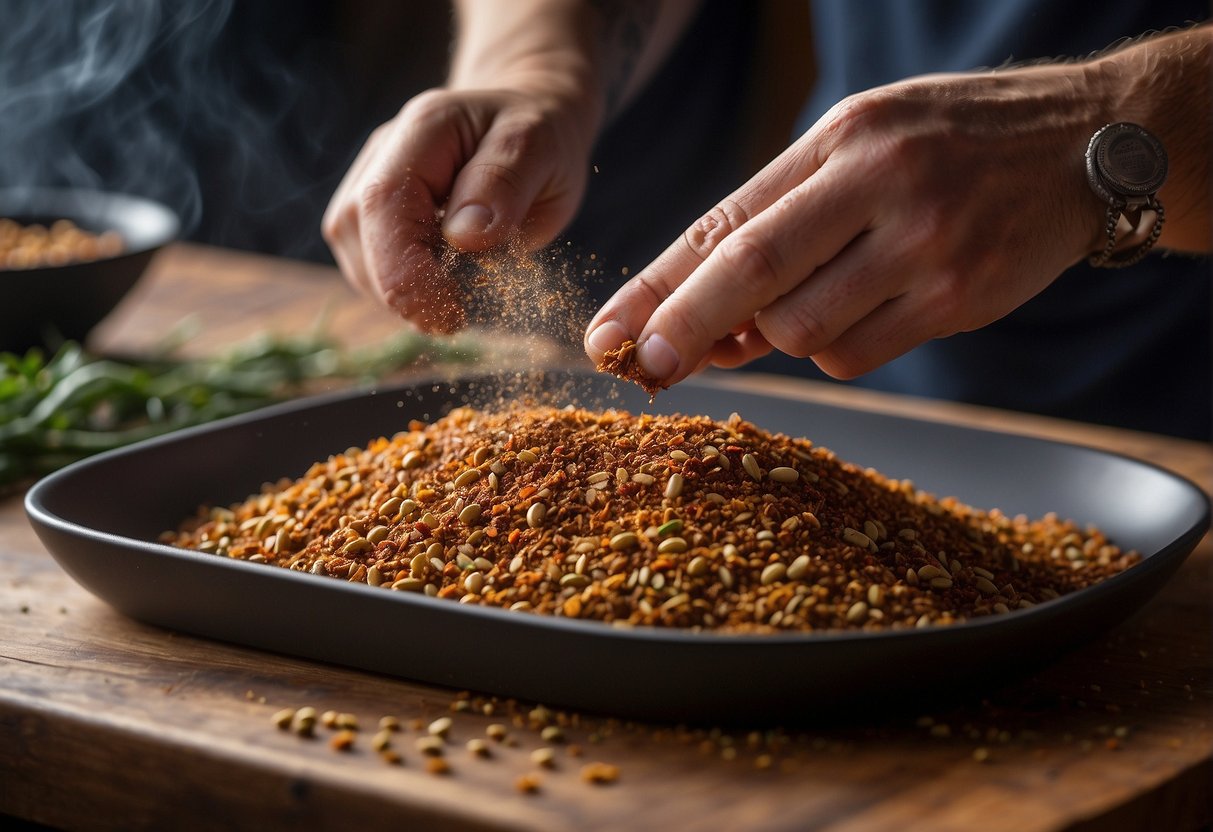
I understand the significance of choosing the right ingredients for the rub and applying them meticulously to ensure the meat is seasoned throughout. In preparing for the low and slow cooking process, applying the rub correctly is just as crucial as the spices you choose. Through this article, you will learn how to select the best brisket, mix a flavorful rub, and master the application to achieve that perfect crust. You’ll also discover why certain spices are chosen and how regional variations can influence your rub creation.
Key Takeaways
- The rub is essential for achieving a flavorful and well-seasoned brisket.
- Proper application of the rub ensures even seasoning and a delectable bark.
- Selecting high-quality ingredients and the right brisket cut are fundamental to the recipe’s success.
Full List of Ingredients and Amounts Needed
To create an award-winning brisket rub, I meticulously select and measure each ingredient to ensure the perfect blend of flavors. My go-to brisket rub consists of the following:
- Coarse Salt: 1/4 cup
- Black Pepper (freshly ground): 1/4 cup
- Paprika (preferably smoked): 3 tablespoons
- Chili Powder: 2 tablespoons
- Onion Powder: 2 tablespoons
- Garlic Powder: 2 tablespoons
- Brown Sugar: 3 tablespoons
- Mustard Powder: 1 tablespoon
- Cayenne Pepper (optional for heat): 1 teaspoon
I ensure that each ingredient is measured accurately for consistency. The combination of these ingredients will be enough to generously cover a 15-pound brisket, highlighting the meat’s natural flavors while adding the signature smokiness and savoriness that competition judges and barbecue enthusiasts love.
In order to blend these ingredients thoroughly, I combine them in a medium-sized bowl, whisking them to uniformity. Storing the rub is simple; I use an airtight container, which helps maintain the rub’s freshness until it’s ready to be massaged onto the brisket. This measured approach allows for a balanced distribution of flavors, ensuring every slice of brisket is as delicious as the last.
Selecting the Right Brisket
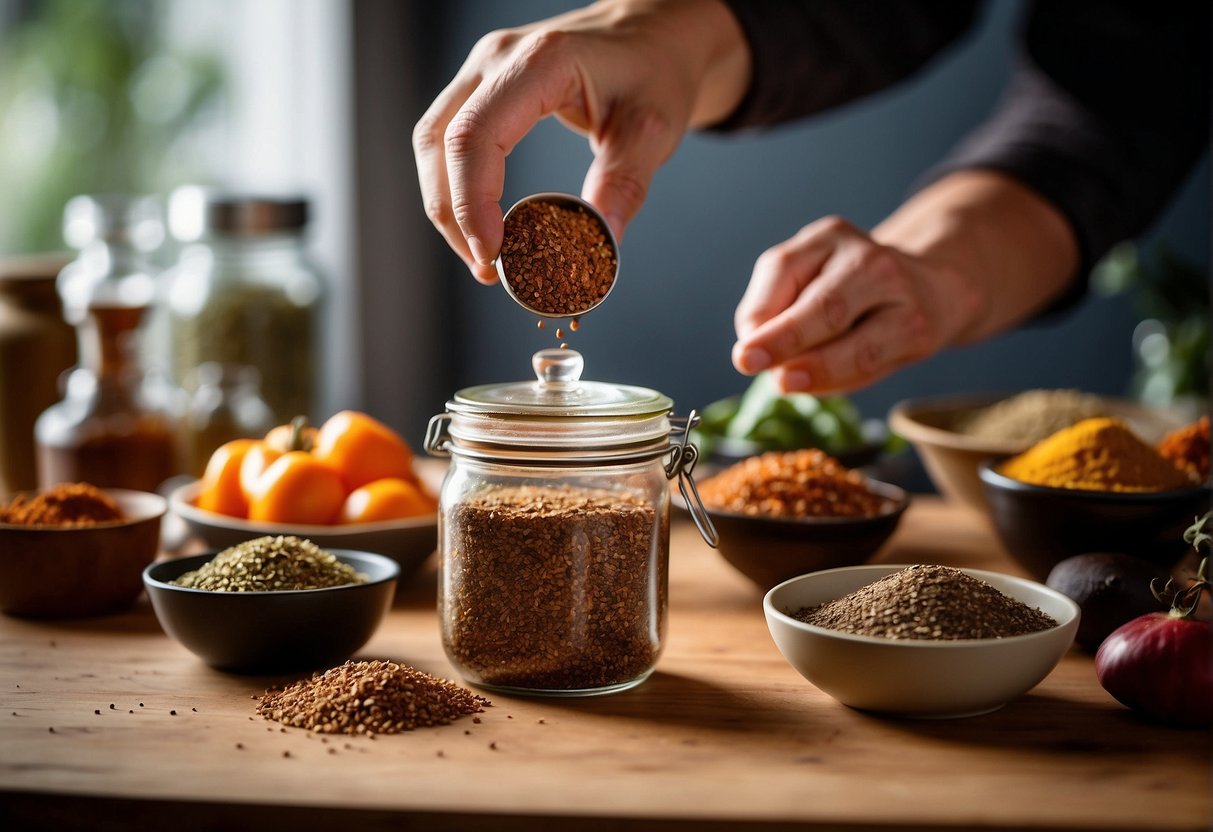
When I prepare my award-winning brisket, selecting the right cut of beef is as important as the rub itself. A good brisket provides the foundation for the flavor and tenderness that a skillful rub and meticulous cooking can elevate.
Understanding Beef Cuts
Brisket is a cut from the lower chest of the beef, a part that bears a significant amount of weight and has abundant connective tissue. Due to this structure, brisket requires low and slow cooking to break down the tissues and render a juicy, flavorful meat. There are two main parts of a brisket: the flat, which is leaner, and the point, which contains more fat and connective tissue. For my rub to work its magic, I prefer a whole “packer” brisket as it includes both sections, offering a variety of textures.
Prepping the Brisket for Rub
Once I’ve selected my brisket, the preparation stage is crucial. I begin by inspecting the fat cap, which should ideally be about a quarter-inch thick to protect the meat during the long smoking process while not being too thick that it prevents the beef brisket rub from penetrating the meat. Trimming excess fat and silver skin ensures an even coating of rub and a good bark formation. I also make sure to score the fat cap slightly in a crisscross pattern which helps the rub adhere better and render the fat more efficiently.
Ensuring Quality and Freshness
The key to an exceptional brisket is its quality and freshness. I always source my beef briskets from reputable, high-quality butchers who provide fresh cuts. The brisket should have a rich, deep red color, and the fat should be white and creamy. I also check for good marbling, as this intramuscular fat gives brisket its renowned taste and maintains moisture at an optimal internal temperature during cooking. Brisket that’s fresh and of high quality will ensure that all the hard work I’ve put into my rub and smoking process pays off in the final, mouthwatering result.
Crafting the Perfect Brisket Rub
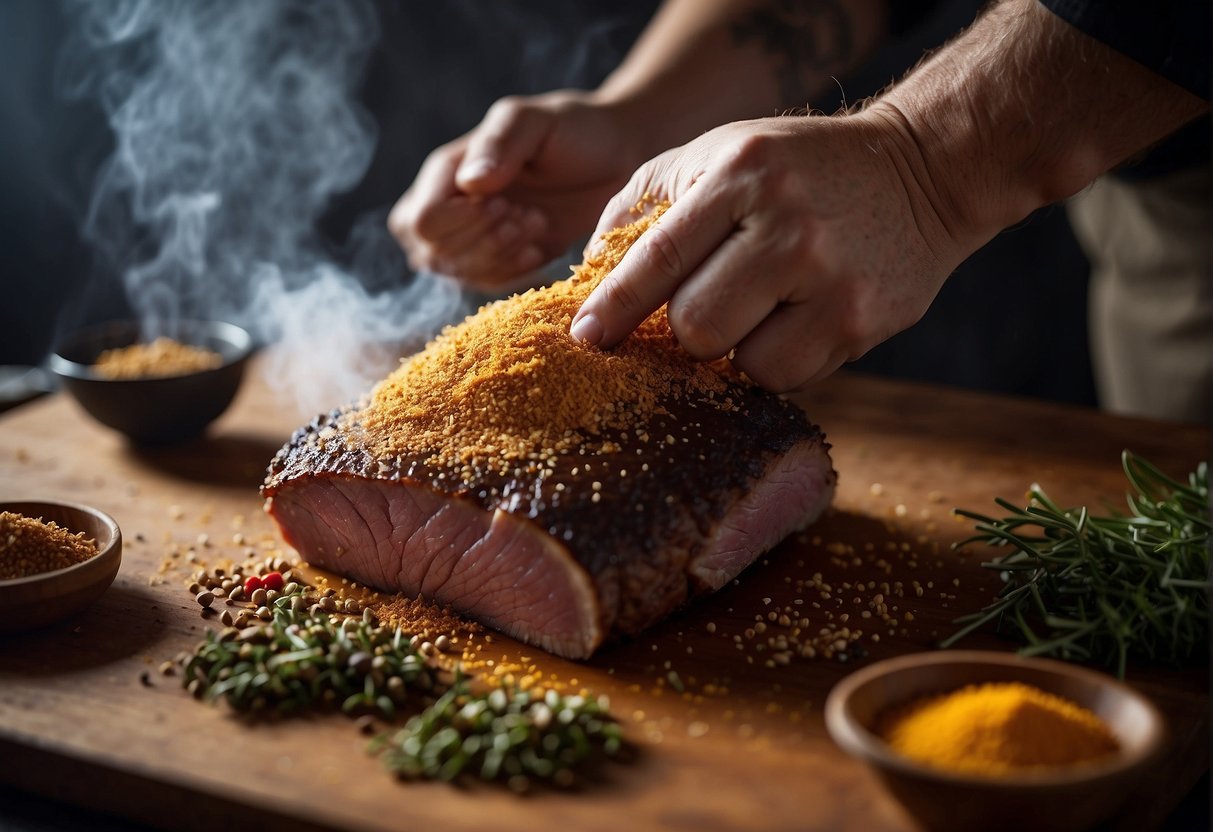
When creating the quintessential brisket rub, I focus on a balance of flavors that can elevate the meat’s taste without overpowering it. Every component has a purpose, enhancing the brisket’s natural savoriness with a combination of sweetness, heat, and aromatic spices.
Balancing Flavors
Achieving the right balance is crucial. I start with a foundation of salt and coarse black pepper to enhance the meat’s natural flavors. From there, I add garlic powder and onion powder for aromatic depth. For a touch of sweetness, I prefer brown sugar or raw cane sugar, which also helps to create a caramelized crust. A combination of paprika, chili powder, and cayenne introduces a warm, smoky heat, while spices like ground cumin, white pepper, and dry mustard add complexity.
- Sweet: Brown sugar, raw cane sugar
- Savory: Garlic powder, onion powder, kosher salt
- Heat: Black pepper, cayenne, chili powder
- Aromatic: Cumin, coriander, paprika
I adjust these components to match the brisket’s size and the desired flavor profile. Mixing them thoroughly ensures every inch of the meat is seasoned evenly.
Homemade Rub versus Store-Bought
While store-bought rubs are convenient, they often contain excess salt and preservatives. A homemade rub lets me tailor the spice mix exactly to my liking and control the quality of ingredients. Making my rub from scratch, I use kosher salt or sea salt for a clean taste and smoked paprika over regular for its rich, smoky aroma.
By storing my homemade blend in an airtight container, I protect its freshness for future use. A proper dry rub recipe requires quality spices; therefore, I prioritize using freshly ground spices like coarse black pepper, granulated garlic, and others like coriander, celery seed, and dried oregano for full-bodied flavor. I skip the artificial additives and embrace natural, potent flavors.
- Homemade Pros: Customizable, fresher ingredients
- Store-Bought Pros: Convenience, pre-measured
By selecting top-notch ingredients and finely tuning the flavor balance, I ensure my brisket rub stands out. Whether I’m looking for a classic salt and pepper profile or a spicy kick, the homemade approach brings out the best in every brisket.
Rub Application Techniques
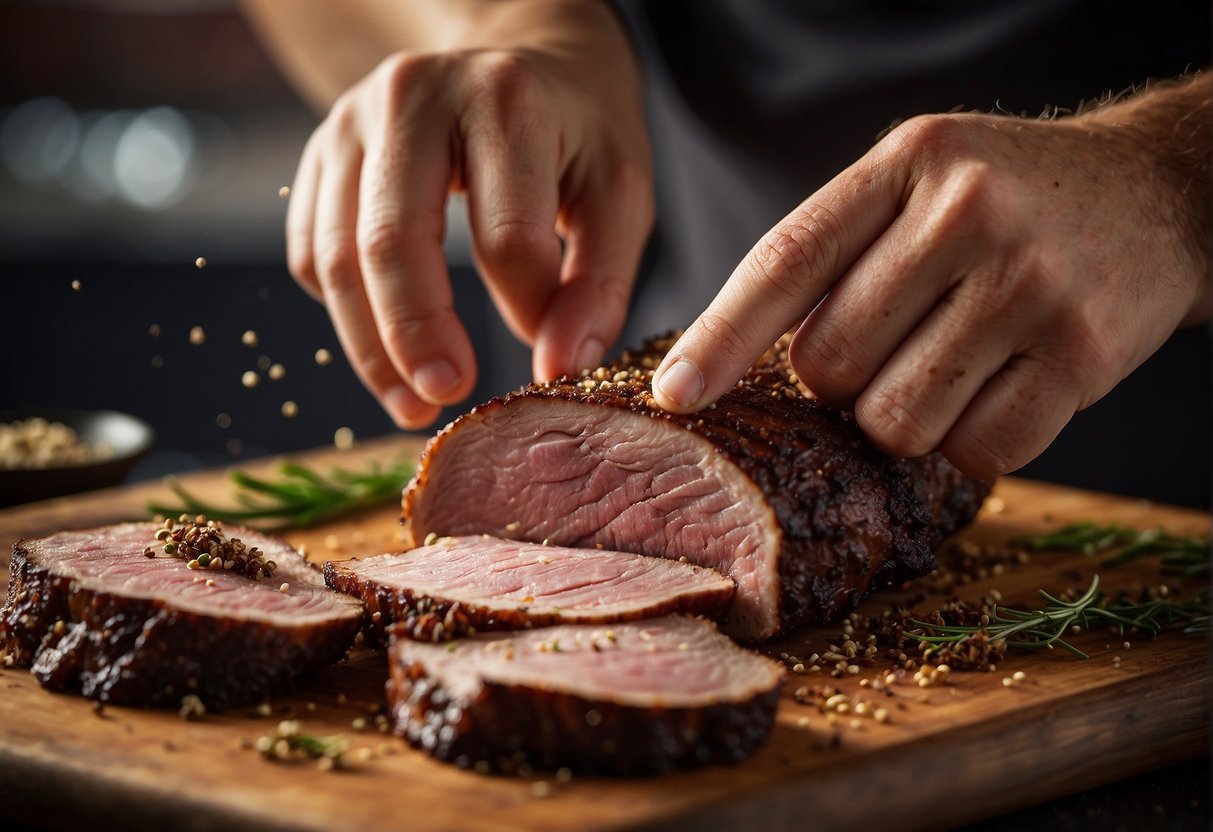
When applying a brisket rub, the key to succulent flavor and an enticing crust is in the method I use to adhere the seasoning to the meat. Proper technique ensures an even coat that will develop into a flavorful bark as the brisket cooks.
Applying a Dry Rub
To apply a dry rub, I start by patting the brisket dry with paper towels. This step is crucial as any excess moisture can cause the rub to clump. Then, I sprinkle my brisket rub evenly across the surface of the meat. I use my hands to press the seasoning into every nook, ensuring consistent coverage. It’s important not to rub it in too vigorously, as this can cause the spices to become overly compacted or uneven.
Creating a Wet Rub Binder
Alternatively, if I’m aiming to amplify the rub’s adhesion, I’ll use a wet rub binder. The technique here involves lightly coating the brisket with a thin layer of olive oil or mayonnaise—both serve as excellent binders. The oil creates a sticky surface for the rub to cling to, and as a bonus, it adds an extra layer of moisture that helps keep the brisket from drying out during cooking. After applying the oil, I then add the brisket rub atop this binder, pressing gently to ensure it holds.
Smoking the Brisket
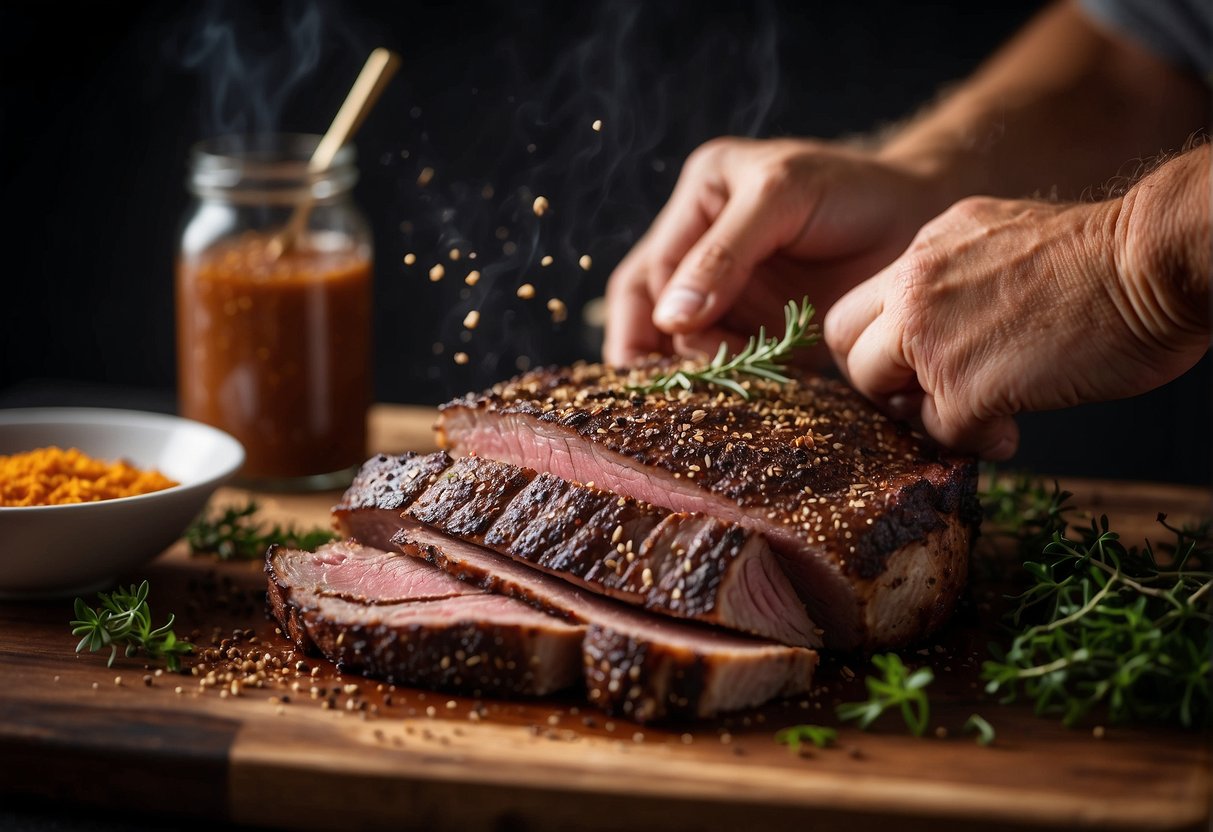
When smoking a brisket, the choice of wood and the control of smoke and temperature are the pillars of flavor and texture. I make sure to select the right wood for my personal taste preference and maintain a steady temperature to achieve the perfect smoke ring.
Choosing the Right Wood
I take great care in choosing the right wood to smoke my brisket. For a robust, natural hickory smoke flavor, I tend to opt for hickory wood. It imparts a strong, bacon-like taste that works well with the beef. However, if I’m in the mood for something a bit milder, apple or cherry wood provides a sweeter, fruitier note. Both hickory and fruit woods create a beautiful smoke ring that signifies a well-smoked brisket.
Smoke and Temperature Control
For smoking brisket, I maintain my smoker at a constant temperature between 225°F and 250°F. This low and slow approach is crucial for a tender, fall-apart texture. I carefully monitor my smoker’s temperature and make adjustments as necessary, ensuring uniform cooking. To enhance the flavors from my beef brisket rub, which often includes cayenne pepper and smoked paprika among other spices, I aim to keep a consistent light blue smoke flowing. This type of smoke ensures that my bbq brisket develops a deep, complex flavor without any bitterness.
Storing and Serving
In my experience as a pitmaster, the proper storing and serving techniques are crucial to presenting a Texas-style brisket that boasts maximum flavor. Ensuring that the beef brisket rub recipe has worked its magic, and the meat has been cooked to perfection, what follows is just as important.
Resting the Brisket
Before slicing, I always allow my brisket to rest. This patience pays off by keeping the juices inside, rather than on the cutting board. Typically, I rest the brisket for at least one hour wrapped in butcher paper or foil. Depending on the size, it can rest for up to several hours, which results in a well-distributed flavor and a crispy bark that Texas barbecue is known for.
Slicing for Maximum Flavor
For slicing, the grain of the beef brisket must be respected. I slice against the grain in about quarter-inch slices. A sharp knife is my best tool here, ensuring I don’t disturb the meat’s texture. The slices reveal not just the juicy interior but the result of my beef brisket seasoning—the dark, rich, flavorful crust that we all strive for.
Accompaniments and Side Dishes
When serving, I enjoy pairing my barbecue with simple sides that compliment, not overpower, the meat. Classics like coleslaw, beans, and grilled vegetables are staples at my table. For those who fancy barbecue sauce, offering it on the side allows each person to choose how much or little they want, ensuring the taste of the brisket remains the star of the show.
Understanding Regional Variations
When I explore the world of barbecue, understanding the regional variations in brisket rub recipes is crucial. Each region has its distinctive flair, contributing to the rich tapestry of flavors we find in this beloved dish.
Texas-Style Brisket Rub
In Texas, simplicity reigns supreme to enhance the beefy flavor of the meat. A classic Texas-style brisket rub typically includes coarse black pepper and kosher salt—often referred to as the “Dalmatian rub.” It might also incorporate garlic and onion powder for additional layers of flavor without overpowering the natural taste of the brisket. Some pitmasters may add a touch of cayenne or chili powder for a subtle kick. Unlike other regions where a marinade or a heavy application of yellow mustard might be used as a base, Texans often prefer the dry rub technique, allowing the rub to form a crusty bark on the brisket during the long smoking process.
Other Regional Influences
Moving beyond the Lone Star State, other regional brisket rubs can include a wider array of spices and vegetables, like chilies, or even unique ingredients like shiitake mushroom powder. Some regions favor a hint of sweetness in their rub, incorporating brown sugar or paprika. The inclusion of MSG is a debated topic, with some arguing it provides an umami beefy flavor, while others prefer to avoid it for health or taste preferences.
Brisket Rub Comparison Table
| Ingredient | Texas-Style Brisket Rub | Other Regional Rubs |
|---|---|---|
| Black Pepper | Essential | Used variably |
| Kosher Salt | Essential | Used variably |
| Garlic Powder | Common | Common |
| Onion Powder | Common | Common |
| Chili Powder | Sometimes | Often |
| Shiitake Mushroom Powder | Rare | Sometimes |
| MSG | Rare | Debated |
| Yellow Mustard (base) | Rare | Occasionally |
| Brown Sugar | Rare | Sometimes |
This table outlines the key differences between the straightforward Texas-Style and the more diverse seasonings found in other regions. Although a brisket rub recipe may share many of the same spices across different areas, it’s the proportions and combinations that define the regional character. Whether you’re using a rub on a traditional Texas brisket or opting for a chuck roast, these varying components can significantly influence the final taste profile.
Frequently Asked Questions
In this section, I’ll cover some of the most common questions about creating an award-winning brisket rub, from essential ingredients to specific techniques for achieving the perfect bark and maintaining meat moisture.
What are the essential ingredients for a championship brisket rub?
A championship brisket rub typically includes a balanced mix of salt, black pepper, paprika, garlic powder, and onion powder. These ingredients create a flavorful crust that enhances the natural taste of the brisket without overpowering it. Here you’ll find a detailed discussion on essential brisket rub ingredients.
How can I achieve a perfect bark on my brisket with a rub?
The secret to a perfect bark is to apply a generous amount of rub that contains enough sugar to caramelize the surface and create a crusty, flavorful bark. The rub should also have a good proportion of salt and other spices to ensure a rich, complex flavor. Consistent cooking temperature is crucial for bark development. More tips for the perfect bark can be found here.
What is the best way to prepare brisket with a rub in a slow cooker?
When preparing brisket in a slow cooker, coat it generously with a rub and let it sit, ideally overnight, before placing it in the cooker. This allows the rub to penetrate the meat. To keep the brisket from getting too moist, place it on a small rack inside the slow cooker. Explore the specifics of slow cooker brisket preparation here.
How do the traditional Texas brisket rub ingredients differ from other recipes?
Traditional Texas brisket rub is known for its simplicity, often relying on a simple mix of coarse salt and coarse black pepper, known as “Dalmatian rub.” This contrasts with other recipes that might incorporate a variety of spices, like cayenne, brown sugar, or even coffee grounds. An example of a traditional Texas-style rub can be seen here.
Can you recommend a brisket rub recipe that helps retain the meat’s moisture?
For moisture retention, my recommendation is a rub that includes brown sugar, which helps seal in the juices. A small amount of dry mustard can also help retain moisture and add flavor complexity. Find a moisture-retentive brisket rub recipe here.
Is it better to apply a dry rub to brisket well in advance or just before cooking?
Applying a rub to the brisket well in advance, ideally the night before, is better as it allows the salt and spices more time to penetrate and flavor the meat. However, a minimum of a few hours before cooking can still yield good results if time constraints are an issue. For guidelines on rub application timing, check this link.
Recipe for Secret Texas Style Brisket Rub
When I craft my Texas Style Brisket Rub, I focus on simplicity and traditional flavors that highlight the meat’s natural succulence. Here’s my award-winning recipe that helps to achieve that perfect bark and deep flavor profile.
Ingredients:
- 1/4 cup of fine Kosher salt
- 1/4 cup of freshly ground black pepper
- 2 tablespoons of paprika
- 1 tablespoon of garlic powder
- 1 tablespoon of onion powder
- 1 teaspoon of cayenne pepper (optional, for heat)
- 2 tablespoons of dark brown sugar (to add a touch of sweetness)
Instructions:
- In a medium mixing bowl, combine the Kosher salt, ground black pepper, paprika, garlic powder, onion powder, and if desired, cayenne pepper.
- Use a fork to carefully break up any clumps of the dark brown sugar before adding it to the mix.
- Stir all the ingredients together until they’re evenly blended.
To apply the rub to your brisket, generously coat the surface of the meat, ensuring an even layer. I usually recommend doing this at least an hour before cooking, though letting it rest overnight in the refrigerator can deepen the flavor even more.
Store any leftover rub in an airtight container. This recipe will cover a 15-pound brisket amply, and you’ll have some leftover for future smokes. For the best experience, mix the rub well as you go – the fine ingredients tend to separate from the black pepper over time.
Remember, your key to a fantastic brisket lies in the quality of the rub and the love you put into preparing it. Enjoy smoking your brisket and savor every mouth-watering bite!

